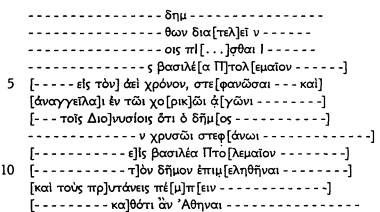Article contents
Ptolemy II and Halicarnassus: An Honorary Decree
Published online by Cambridge University Press: 23 December 2013
Extract
This white marble slab was cut into its present shape when the verso was incised for use as a decorative panel. An unknown amount of text is therefore missing on all sides, while a few spots in the middle make for difficult reading because of patches of mortar and some pick marks, notably in the first two lines. I am unable to guess at the original length of line, other than to say that it was considerably longer than what is preserved here.
Height, 0·24 m.; width, 0·187 m; thickness, 0·043 m.
Height of letters, 0·011–0·014 m.

At some time between 1960 and 1964, this inscription was brought to the Castle of St. Peter in Bodrum, which has in recent years doubled as the Bodrum Museum under the wise and careful supervision of Director Halık Elbe. Unfortunately, no one today knows who brought the stone in, or where it had been found, for the Museum fell heir to a vast store of material of archaeological value before any system of cataloguing could be devised.
- Type
- Research Article
- Information
- Copyright
- Copyright © The British Institute at Ankara 1971
References
1 Compare Bean, G. and Cook, J., “The Halicarnassus Peninsula”, BSA 50 (1955), 107, no. 35Google Scholar; Wilhelm, A., “Inschriften aus Halikarnassos”, JOAI 11 (1908), 53, 56Google Scholar.
2 Kern, O., Inschriften von Magnesia (Berlin, 1900) no. 46.38Google Scholar.
3 E.g., the alliance between Sparta and Athens on the eve of the Chremonidean War, IG ii2 686.26.
4 CompareIG ii 2Google Scholar 646.24, 651.17, 655.17, etc. However, καί is also omitted in BCH 14 (1890), 91Google Scholar, no. 1.10–11, from Halicarnassus.
5 Hauvette-Besnault, and Dubois, , BCH 5 (1881), 212Google Scholar, no. 6.1–3.
6 Habicht, C., “Samische Volksbeschlüsse der hellenistischen Zeit”, Ath. Mitt. 72 (1957), 152 ff. passimGoogle Scholar.
7 In correspondence, Welles noted that the letter shapes are closer to an example like Kern, O., Inscriptiones Graecae (Bonn, 1913), no. 31Google Scholar (Priene, late fourth century), than they are to late third century decrees from Attica and elsewhere.
8 JOAI 11 (1908), 53Google Scholar, photo of squeeze on p. 56. Tau has the crossbar overbalanced to the left, particularly before iota. Omega is circular, with long bases, which flare upward slightly. Sigma and mu seem to have the long hastae parallel, but there is in fact a suspicion of flare. On Wilhelm's stone, phi has a torpedo shaped oval, with angular ends. Only such a phi could produce the angle that is the only surviving vestige of phi on the present stone, at the end of line 8. A comparison of Wilhelm line 6, φιλοτιμίαν and the present stone, line 12 [κα]θότι, will show an identically irregular spacing of the letters OTI. On both stones, apices are prominent, omicron and theta are cut on the same circle, and are slightly smaller than other letters.
9 E.g., , J. and Robert, L., La Carie II (Paris, 1954), P1. xlviiGoogle Scholar (Apollonia) and P1. xvi (Muğla), both early second century. Serifs are prominent, pi has grown a longer second hasta, omega, omicron and theta are diminutive.
10 An outside possibility might be that the honours are to be visible “for all time” as in IG xii.7, 389.36Google Scholar, but an agreement is more probable.
11 BCH 5, 212Google Scholar (cited above, note 5);. SIG 3 426.35 ff.
12 Dated to 2 58 by Tarn, W. W., CAH VII 862Google Scholar; E. Bickerman showed good reason to believe the battle of Cos concluded the naval activity of the Chremonidean War, “Sur les batailles navales de Cos et d'Andros”, REA 40 (1938), 369 ffCrossRefGoogle Scholar; cf. Will, E., Histoire politique du monde hellénistique I (Nancy, 1966), 200–202Google Scholar.
13 See P. Cairo Zen. 59036, cited below, which is evidence for strict Ptolemaic control of Caria. and is dated 257.
14 Ferguson, W. S., Hellenistic Athens (London, 1911), 152Google Scholar, note 4.
15 [Plutarch, ] Vit. X Orat. 851EGoogle Scholar.
16 IG ii2 682.28–30.
17 ![]()
![]() etc., quoted by Athenaeus XI 502B; cf. Ferguson, , Hellenistic Athens, 170–73Google Scholar.
etc., quoted by Athenaeus XI 502B; cf. Ferguson, , Hellenistic Athens, 170–73Google Scholar.
18 Schede, M., “Aus dem Heraion von Samos”, Ath. Mitt. 44 (1919), 21–23Google Scholar. Two recent articles extensively treat Philocles and other Ptolemaic officials in the Aegean: Merker, Irwin, “The Ptolemaic Officials and the League of the Islanders”, Historia 19 (1970), 141 ffGoogle Scholar; Jakob Seibert, “Philokles, Sohn des Apollodorus, König der Sidonier”, ibid 337 ff.
19 IG XI.4, 565; cf. Merker, , loc. cit. 153Google Scholar and note 56.
20 OGIS 16, with the remarks of Greipl, Nelly, “Über eine Ptolemäerinschrift”, Philologus 85 (1929/1930), 159/74CrossRefGoogle Scholar.
21 Contemporary opinion of Ptolemaic expansion in Theocritus XVII 89; control of Caria is discussed by Rostovtzeff, M., Social and Economic History of the Hellenistic World I, 334–39Google Scholar, with III 1399 f., notes 130, 131, 132a; cf. Tarn, , “Ptolemy II”, JEA 14 (1928), 250Google Scholar, and now the long discussion of Ptolemaic imperialism in Will, Histoire Politique I, 133–186Google Scholar.
22 JOAI 11, 53 ffGoogle Scholar (cited above, note 1).
23 Reprinted with translation in Hunt, and Edgar, , Select Papyri II (London, 1934), no. 410Google Scholar.
24 This general, Aristolaus of Macedon, was honoured by the Samians: see Habicht [note 6 above], no. 57. His date is confirmed by a statue of Ptolemy II which he dedicated at Olympia, Pausanias VI 17.2, noted by Habicht.
25 Habicht, ibid. no. 21.
26 IG ii 2 646, 655, 657, 663, 677, etcGoogle Scholar.
27 IG ii 2657Google Scholar; cf. Plutarch, , Demetrius 12.3Google Scholar.
- 4
- Cited by


